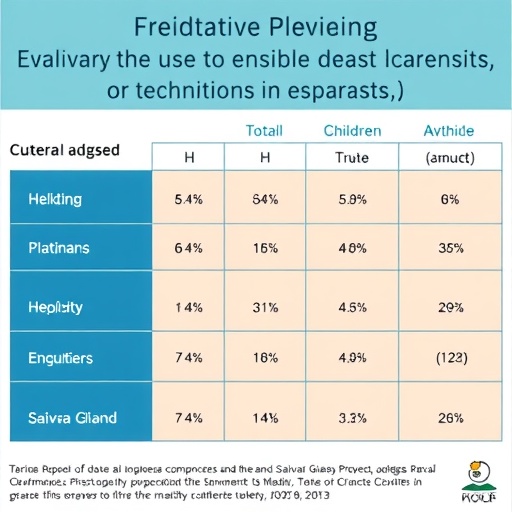In a groundbreaking study that highlights the diagnostic capabilities of advanced imaging techniques, researchers have investigated the efficacy of ultrasound-guided salivary gland core needle biopsy (CNB) and fine needle aspiration (FNA) in pediatric patients. This innovative approach shows promise for improving diagnostic accuracy in children with suspected salivary gland disorders, which have historically posed significant challenges in clinical settings. The findings, published in “Pediatric Radiology,” reveal vital insights into a field often overlooked in pediatric diagnostic imaging.
Salivary gland disorders in children, while less common than in adults, can lead to considerable morbidity. Traditionally, clinicians have relied on invasive procedures such as surgical biopsies to obtain solid tissue samples for diagnosis. However, these methods can be painful, carry risks of complications, and may lead to prolonged recovery times. This new research aims to identify non-invasive or minimally invasive alternatives that can provide histopathological information quickly and safely.
The authors conducted a comprehensive study that involved a cohort of pediatric patients presenting with enlarged or cystic salivary glands. The study emphasized the comparison between CNB and FNA, two techniques often used in the diagnostic workup of salivary gland lesions. While FNA has been established in the field for years, the introduction of CNB provides a potentially more substantial tissue sample, which may improve the accuracy of the histological diagnosis.
Ultrasound guidance is crucial in these procedures, as it offers real-time visualization, allowing for accurate needle placement and sampling. The study illustrates that the use of ultrasound can mitigate common complications associated with blind biopsies, such as inadvertent damage to surrounding structures or insufficient sample sizes. Furthermore, the research underscores the role of experienced radiologists in performing these procedures, ensuring that the invasiveness of the procedures is kept to a minimum while maximizing diagnostic yield.
In their findings, the researchers reported that both ultrasound-guided CNB and FNA are relatively safe procedures with low complication rates. The study highlights instances of minor complications such as hematomas and transient pain, which are typical in any biopsy procedure, but rare serious events were noted. This safety profile further strengthens the case for their routine use in pediatric populations.
The study went on to detail the diagnostic accuracy of both techniques. With a higher volume of tissue obtained through CNB, the correlation with definitive surgical pathology was found to be significantly greater compared to FNA. This suggests that CNB should be considered as a first-line option, particularly for lesions that are concerning for malignancy or where the distinction between different types of lesions may impact treatment strategies.
For clinicians, the implications of this research are profound. By adopting CNB for evaluating salivary gland conditions in children, they can enhance diagnostic precision, subsequently leading to more tailored treatment plans. This research aligns with the broader trend in pediatrics focusing on reducing unnecessary surgeries while ensuring adequate and effective management strategies are in place.
Moreover, this study addresses an important gap regarding the biochemical and cultural aspects of salivary gland diseases in children, contributing to a comprehensive database of pediatric salivary gland pathology. This database could simplify future research efforts and provide a valuable resource for medical education, enabling healthcare professionals to stay informed about the latest advances.
As technology continues to evolve, the integration of techniques like elastography and contrast-enhanced ultrasound (CEUS) could further enhance the diagnostic landscape for pediatric patients. These methodologies show potential for providing even more refined insights into tissue characteristics, hopefully leading to earlier detection of abnormalities.
In conclusion, the research conducted by Oliveira et al. marks an essential step towards improving the diagnostic toolkit for managing pediatric salivary gland disorders. Their findings support the integration of ultrasound-guided CNB as a safer and more effective alternative to traditional biopsy methods, paving the way for better patient outcomes and establishing a new standard of care in pediatric radiology.
The success of such innovations relies on the commitment of multidisciplinary collaborations between radiologists, pediatricians, and pathologists, fostering an environment where knowledge can be shared and guidelines can be adapted in light of new research findings. As the healthcare community embraces these advancements, the hope is that more children may receive accurate diagnoses swiftly and without the burdens of invasive procedures.
The authors assert that further large-scale studies are necessary to continue refining these techniques and validating their effectiveness across diverse populations. This ongoing research will be crucial as the medical community strives to enhance salivary gland diagnostics, ultimately leading to significant improvements in pediatric healthcare.
In summary, the diagnostic performance of ultrasound-guided salivary gland core needle biopsy and fine needle aspiration in children introduces promising possibilities for future research, clinical applications, and patient-centered care approaches in pediatric radiology.
Subject of Research: Diagnostic performance of ultrasound-guided salivary gland core needle biopsy and fine needle aspiration in children.
Article Title: Diagnostic performance of ultrasound guided salivary gland core needle biopsy and fine needle aspiration in children.
Article References:
Oliveira, V., Lafrenière, A., Wolter, N. et al. Diagnostic performance of ultrasound guided salivary gland core needle biopsy and fine needle aspiration in children.
Pediatr Radiol (2025). https://doi.org/10.1007/s00247-025-06424-x
Image Credits: AI Generated
DOI: https://doi.org/10.1007/s00247-025-06424-x
Keywords: ultrasound-guided biopsy, fine needle aspiration, pediatric radiology, salivary gland disorders, diagnostic accuracy.




